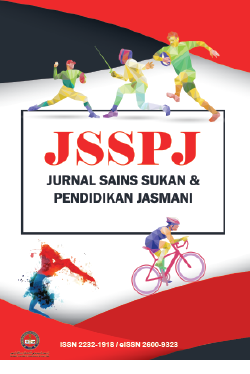Relationship between Physical Activity and Organizational Barriers toward Teachers Work Stress Level
Hubungan Antara Aktiviti Fizikal Dan Halangan Organisasi Terhadap Tahap Stres Bekerja Guru
DOI:
https://doi.org/10.37134/jsspj.vol10.1.8.2021Keywords:
physical activities, work stress, barriers of physical activitiesAbstract
The purpose of this study was to identify level of physical activity, level of work stress and barriers of physical activities among school teachers in Perak state. Besides, this study examined the relationship between level of physical activity and level of work stress as well as level of physical activity and barriers of physical activities. The instrument of this study is Questionnaire. Population of this study is school teachers in Perak state (N=380). Result of this study shown that level of physical activity ranked accordingly is low, medium and high while level of work stress ranked accordingly is medium, low and high. Structure and organization factor was the main barriers of physical activities among school teachers. Pearson correlation shown there are relationship between level of physical activity and level of work stress. However, the strength of relationship is very week. Besides, the result also shown that there are significant relationship between level of physical activity and barriers of physical activities, but the strength of relationship is very week as well. In conclusion, to increase level of physical activity and lower level of work stress, the barriers of physical activity must be minimal. Several implications and suggestions were highlighted for further action and future research.
Downloads
References
AIA Vitality. (2018). Malaysia's Healthiest Workplace 2018. Retrieved from https://healthiestworkplace.aia.com/malaysia/eng/
Bethancourt, H. J., Rosenberg, D. E., Beatty, T., & Arterburn, D. E. (2014). Barriers to and facilitators of physical activity program use among older adults. Clin Med Res, 12(1-2), 10-20. doi: https://10.3121/cmr.2013.1171
Chin T. S. (2013). The Effect Of Recreational Sport Involvement On Work Stress And Quality Of Life In Central Taiwan. Social Behavior & Personality: an international journal, 41(10), 1705.
Florin, D. (2018). Sedentarism and Benefits of Regular Physical Activity in Healthy Adults. Ovidius University Annals, Series Physical Education and Sport/Science, Movement and Health, 18(1), 97-103.
Garcia, S. F., Hahn, E. A., Magasi, S., Lai, J. S., Semik, P., Hammel, J., & Heinemann, A. W. (2015). Development of self-report measures of social attitudes that act as environmental barriers and facilitators for people with disabilities. Arch Phys Med Rehabil, 96(4), 596-603. doi: https://10.1016/j.apmr.2014.06.019
Herazo-Beltran, Y., Pinillos, Y., Vidarte, J., Crissien, E., Suarez, D., & Garcia, R. (2017). Predictors of perceived barriers to physical activity in the general adult population: a cross-sectional study. Brazilian Journal of Physical Therapy, 21(1), 44-50.
Herr, R. M., Barrech, A., Riedel, N., Gündel, H., Angerer, P. & Li, J. (2018). Long-Term Effectiveness of Stress Management at Work: Effects of the Changes in Perceived Stress Reactivity on Mental Health and Sleep Problems Seven Years Later. Int. J. Environ. Res. Public Health, 15(2), 255; https://doi.org/10.3390/ijerph15020255
Khairy Jamaluddin. (2016) KBS baru sedar rakyat kurang bersukan/Interviewer: Kosmo. majlis pelancaran acara maraton HSN21KM KBS, Galeri KBS.
Lee, S. A., Ju, Y. J., Lee, J. E., Hyun, I. S., Nam, J. Y., Han, K. T., & Park, E. C. (2016). The relationship between sports facility accessibility and physical activity among Korean adults. BMC Public Health, 16, 893. doi: https://10.1186/s12889-016-3574-z
MacFarlane, L., & Montgomery, C. (2010). Influencing the Mind Through the Body: A Theoretical Model for Coping With Student Teacher Stress Through Physical Exercise. Journal of Cognitive Education and Psychology, 9(2), 183-197 doi: https://10.1891/1945-8959.9.2.183
Malm, C., Jakobsson, J. & Isaksson. A (2019). Physical Activity and Sports—Real Health Benefits: A Review with Insight into the Public Health of Sweden. Sports MDPI, 7(5), 127; https://doi.org/10.3390/sports7050127
Merom, D., Pye, V., Macniven, R., van der Ploeg, H., Milat, A., Sherrington, C., . . . Bauman, A. (2012). Prevalence and correlates of participation in fall prevention exercise/physical activity by older adults. Prev Med, 55(6), 613-617. doi: https://10.1016/j.ypmed.2012.10.001
Mikkelsen, K., Stojanovska, L., Polenakovic, K., Bosevski, M. & Apostolopoulo, V. (2017). Exercise and mental health. Maturitas, 106, 48-56. https://doi.org/10.1016/j.maturitas.2017.09.003
Nazare, J. A., Smith, J., Borel, A. L., Almeras, N., Tremblay, A., Bergeron, J., . . . Despres, J. P. (2013). Changes in both global diet quality and physical activity level synergistically reduce visceral adiposity in men with features of metabolic syndrome. J Nutr, 143(7), 1074-1083. doi: https://10.3945/jn.113.175273
Sajida Asarulah Khan. (2018). Guru Paling Stres. Utusan Malaysia. Retrieved from https://www.utusan.com.my/berita/nasional/guru-paling-stres-1.717093
Skakon, J., Kristensen, T. S., Christensen, K. B., Lund, T., & Labriola, M. (2011). Do managers experience more stress than employees? Results from the Intervention Project on Absence and Well-being (IPAW) study among Danish managers and their employees. Work, 38(2), 103-109. doi: https://10.3233/WOR-2011-1112
Tai, K. L., Ng, Y. G., & Lim, P. Y. (2019). Systematic review on the prevalence of illness and stress and their associated risk factors among educators in Malaysia. PLoS One, 14(5), e0217430. doi: https://10.1371/journal.pone.0217430
Tavares, L. S., & Plotnikoff, R. C. (2008). Not enough time? Individual and environmental implications for workplace physical activity programming among women with and without young children. Health Care Women Int, 29(3), 244-281. doi: https://10.1080/07399330701880911
Vankim, N. A., & Nelson, T. F. (2013). Vigorous physical activity, mental health, perceived stress, and socializing among college students. Am J Health Promot, 28(1), 7-15. doi: https://10.4278/ajhp.111101-QUAN-395





